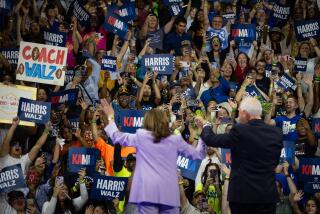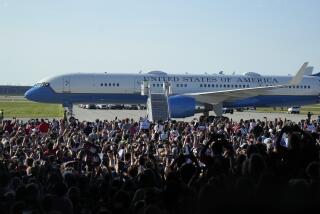Glenn Beck and the science of crowd counts
- Share via
Question: What do Glenn Beck’s “Restoring Honor” extravaganza, held on the Washington Mall on Aug. 28, and a test for male infertility have in common?
Answer: If you do your counting wrong for either of them, you can come to wildly inappropriate conclusions.
When asked how large the crowd at his rally was, Beck offered a range of 300,000 to 650,000 and, after the fact, has reportedly settled on 500,000. These are quite impressive numbers, and they’ve been widely quoted. One might, however, be forgiven for suspecting that Beck had reason to guess high, in order to magnify the significance of his attempt to “restore” God to the American political arena, and the wide range of Beck’s estimate might make one wonder where it comes from.
Skepticism is not, of course, the sole province of politics. It is at the heart of science, and the first question a scientist might ask is where’s the empirical evidence for this or any crowd estimate.
Counting crowds has a long tradition of controversy and inherent inaccuracy. Published estimates of crowds at President Obama’s inauguration, for example, ranged from 800,000 to 4 million. Clearly, when it comes to such large numbers of people, no one can count every head. So is it even possible to make reliable empirical estimates? It is if you do it the way doctors determine whether men are infertile.
An average male in the United States produces about 60 million sperm per milliliter of semen. No one, of course, counts all the sperm. Rather, doctors count the number of sperm in a minute sample, which is assumed to be representative. They then divide by the volume of the sample to get the density of sperm, which can then be multiplied to estimate the amount in any given volume.
Applying a similar method, based on detailed aerial and ground photographs of the entire site at noon (when it was thought attendance would peak), Steve Doig, a journalism professor at Arizona State University who specializes in quantitative research methods, made density estimates in eight different areas of the crowd (including under the trees). He then used Google Earth to estimate the square footage of the various different regions. He came up with crowd sizes in the different regions, which he added up over the whole rally area for an estimate of 80,000 attendees.
Ryan Shuler, who is an image analyst for AirPhotosLive, the research company that supplied the crowd photographs, used the same pictures and a slightly different method to make his estimate. He created a grid of small squares on the photos, counted individuals in a selected sample of squares and came up with a count of 87,000. The two estimates are well within AirPhotosLive’s expected margin of error (in this case, 9,000 attendees).
CBS News went with the higher of the two estimates. But it wasn’t high enough for the conservative blogosphere — or for Beck, who accused the mainstream media of downplaying his event. Interestingly, Doig’s methodology in estimating the crowd at Obama’s inauguration to be 800,000 was widely praised by the same groups that are now vilifying the estimate for the Restore Honor rally.
Does it matter whether the crowd at the event was 80,000 or 650,000? That depends, of course, on who you are and what you are trying to interpret. However, crowd counting is not something that should be pulled out of thin air. Presumably, informing the public about the true nature of an event as controversial as Beck’s rally is at least as important as letting men know the likelihood that they can have kids.
If fertility doctors used the same slipshod estimation methods that Beck used, there would be a lot more happy — or unhappy — accidents walking around the country today.
Lawrence Krauss is director of the Origins Project at Arizona State University.






